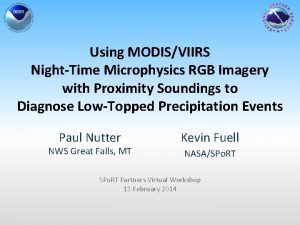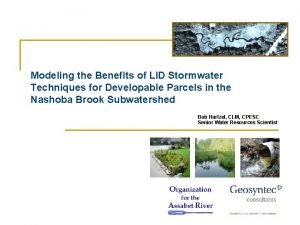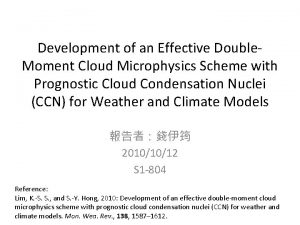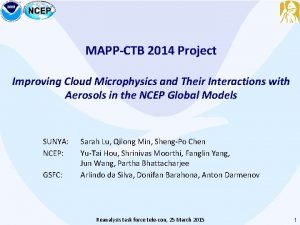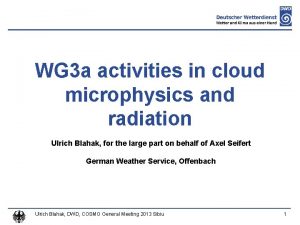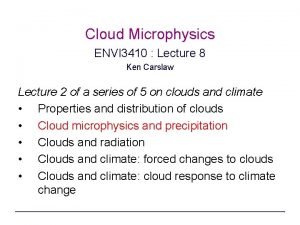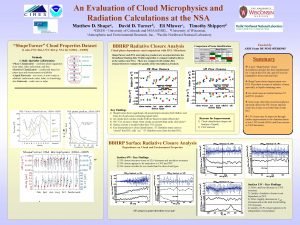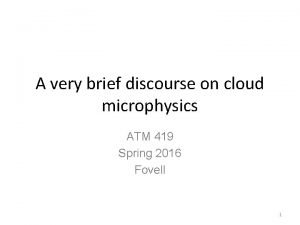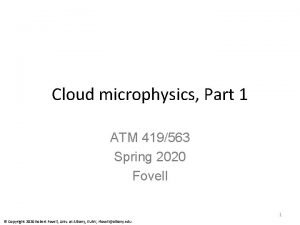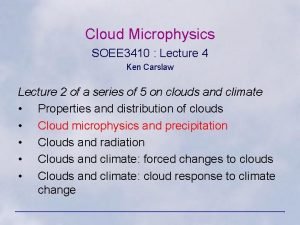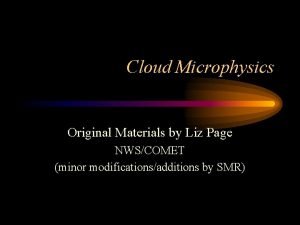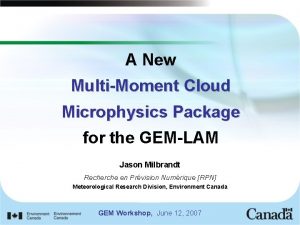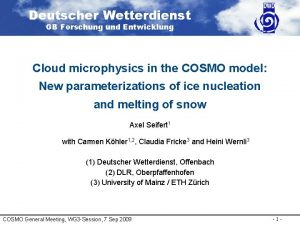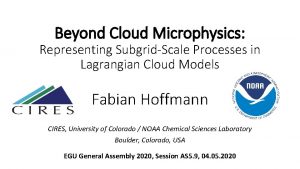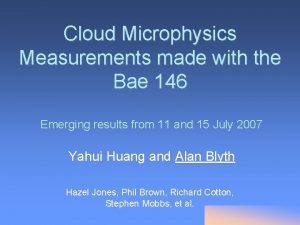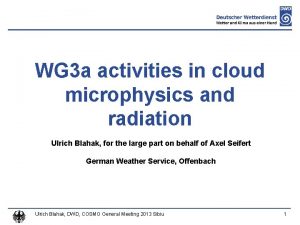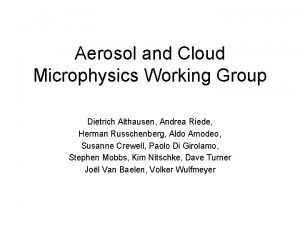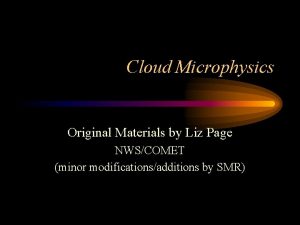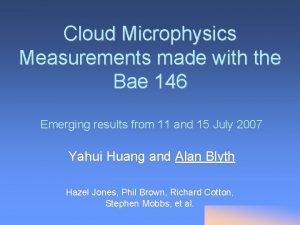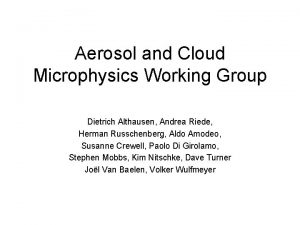Impact of Cloud Microphysics on the Development of






























- Slides: 30

Impact of Cloud Microphysics on the Development of Trailing Stratiform Precipitation in a Simulated Squall Line: Comparison of One- and Two-Moment Schemes Reporter: Prudence Chien Reference: Morrison, H. , G. Thompson, V. Tatarskii, 2009: Impact of cloud microphysics on the development of trailing stratiform precipitation in a simulated squall line: comparison of one- and two-moment schemes. Mon. Wea. Rev. , 137, 991– 1007.

Outline • • • Keywords Motivation Experimental design Results Summary & conclusions

• Squall line Keywords • A line of active thunderstorms, either continuous or with breaks, including contiguous precipitation areas resulting from the existence of the thunderstorms. The squall line is a type of mesoscale convective system distinguished from other types by a larger length-to-width ratio. Conceptual model of a squall line

Aggregation Deposition Melting layer Evaporation (Biggerstaff & Houze 1991) Collision Coalescence

Keywords • N 0 jump N 0 r decreases rapidly during the transition from convective to widespread stratiform rain. Drop Size Distribution (DSD) N 0: intercept Λ: slope μ: shape parameter D: particle diameter (吳子瑜 2008)

Keywords • Two-moment scheme (double-moment scheme) – One-moment scheme (single-moment scheme) – Predicts mass mixing ratio(q) and number concentration(N) – 5 hydrometer species: cloud droplets, cloud ice, snow, rain, and graupel

Motivation • In general, models cannot catch squall-line features very successfully, the transition zone and the trailing stratiform region in particular. • Limitation: – Bulk schemes assume an underlying shape for the hydrometeor size distribution, and predict one or more bulk quantities of the distribution. – Bin microphysics schemes not feasible for most application. • Compare the Impact of one- and two-moment scheme on the evolution of an idealized 2 -D squall line.

Experimental design • WRF V 2. 2 • 2 D idealized squall-line case • Horizontal domain: 600 km, Δx = 1000 m Vertical domain: 20 km, Δz = 250 m • Simulated period: 7 h, Δt =5 s • Environmental temperature and moisture profile: Weisman and Klemp (1982, 1984) • Thermal bubble: θmax= 3 K at 1. 5 km height • Specified N 0 r = 107 m-4 in 1 -M

Results • • Storm Morphology Precipitation and Cold Pool Mesoscale Dynamics Convective Updrafts

1) Storm morphology qx (thin solid line) Θ’ = -2 K (thick solid line) Wind vector (arrows) 1 -M 2 -M SF CV • Much narrower and weaker region of trailing stratiform precipitation in 1 -M • Radar reflectivities in 1 -M are lower than 2 -M in the stratiform region • Large rain evaporation rate between the melting layer and the surface in the stratiform region in 1 -M

2) Precipitation and the cold pool Surface rainfall rate 2 -M 1 -M 2 -M : Larger rain rate in stratiform region Slightly smaller rain rate in convective region

Rain mixing ratio Rain evaporation rate SF CV Larger rain evaporation rate in 1 -M leads to smaller rain mixing ratio than 2 -M below the melting layer.

2 -M warmer than 1 -M (shaded gray) Rain intercept parameter (N 0 r) SF CV Difference in perturbation potential temperature SF CV • Larger value of N 0 r leads to larger evaporation rate. • Largest values of N 0 r occur in the convective region, and steadily decrease through the trailing stratiform region. • The increased evaporation rate in the stratiform region leads to a broader and generally colder cold pool in 1 -M than 2 -M.

2 -M > 1 -M (shaded gray) 3) Mesoscale dynamics Difference in vertical velocity SF CV Difference in buoyancy SF CV The mesoscale updraft at midlevels of the stratiform region is stronger in 2 -M than 1 -M. Main factor: (1)Latent heating rate (2)Rearward horizontal fluxes of condensate and buoyancy

Difference in latent heating rate SF CV Latent heating rate due to vapor deposition growth of ice is greater in 2 -M than 1 -M in the stratiform region.

2 -M > 1 -M (shaded gray) Difference in front-to-rear flux of buoyancy SF CV Difference in front-to-rear flux of condensate SF CV • Much larger flux of buoyancy at midlevels from the convective to the stratiform region in 2 -M than in 1 -M. • Much smaller amounts of ice condensate in the convective region in 2 -M than 1 -M. => Rearward flux of condensate from the convective region tends to be much smaller in 2 -M than in 1 -M.

4) Convective updrafts Sensitivity simulation of evaporation rate Calculate rain evaporation rate by limiting N 0 r’s maximum=107 m-4 in convective region (2 -M*) Difference in vertical velocity SF CV 2 -M > 2 -M* (gray shaded) Rain evaporation are reduced in convective region, leading to reduced latent cooling and increased mean convective updraft intensity.

Sensitivity simulation of evaporation rate Difference in front-to-rear flux of buoyancy SF CV Difference in front-to-rear flux of condensate 2 -M > 2 -M* (gray shaded) • Reduced rearward flux of positively buoyant air to stratiform region • Increased rearward flux of condensate

1 -M ( N 0 r=107 m-4) 1 -M sensitivity test 1 -M* ( N 0 r=2*106 m-4) SF CV 2 -M • Reduced rain evaporation rate • Produce much more trailing stratiform precipitation • The leading edge of convective precipitation is poorly defind. • Cold pool is much weaker than in 2 -M • Smaller rearward buoyancy and condensate flux at midlevels into the stratiform region • Reflectivities are weak above the melting layer compared to 2 -M

1 -M sensitivity test 1 -M ( N 0 r=107 m-4) 1 -M* ( N 0 r=2*108 m-4) SF CV 2 -M • Increased rain evaporation rate • Very little surface rainfall in the stratiform region • Increased rearward flux of positively buoyancy into the stratiform region • Reflectivities are weak above the melting layer compared to 2 -M => The importance of capturing the variability of N 0 r between the straitiform and convective region. Two-moment schemes allow a more rigorous treatment of N 0 r

Summary & conclusion • 2 -M scheme produced a much more widespread and prominent region of stratiform precipitation, relative to 1 M scheme. • Key factor: reduced rain evaporation rate in the stratiform region in 2 -M – Larger mean raindrop size in 2 -M than in 1 -M in the stratiform region directly contributed to the larger radar reflectivity. • Secondary factor: increased rain evaporation rates in the convective region at midlevels – Reduction in the intensity of the convective updrafts. – An increased flux of positively buoyant air at midlevels from the convective to stratiform region. – An increased intensity of the mesoscale updraft.

• Difference in the rain evaporation rate between 1 -M and 2 -M were the result of differences in the rain size distribution parameters. – Larger N 0 r in the convective region were associated with significant collision-coalescence; in contrast, rain in the stratiform region was primarily produced by melting of snow. – The variability of N 0 r is consistent with surface disdrometer measurements. There a sharp decrease in N 0 r(N 0 jump) between convective and stratiform region.

• Rain evaporation plays a key role in the development of the trailing stratiform region. Rain evaporation rate is sensitive to the number concentration in the 2 -M scheme. • A scheme with two-moments predicted for rain only was able to reproduce the stratiform region features using the full 2 -M scheme.

Thanks for your attention. Questions?


Gamma function:

Rain evaporation rate



2 -M vertical velocity Positive vertical velocity (gray shaded)
 Nighttime microphysics
Nighttime microphysics Pods aggregation and silos in cloud computing
Pods aggregation and silos in cloud computing Cloud integration patterns
Cloud integration patterns Public cloud vs private cloud cost analysis
Public cloud vs private cloud cost analysis Share data
Share data Low impact development
Low impact development Low impact development
Low impact development Hình ảnh bộ gõ cơ thể búng tay
Hình ảnh bộ gõ cơ thể búng tay Ng-html
Ng-html Bổ thể
Bổ thể Tỉ lệ cơ thể trẻ em
Tỉ lệ cơ thể trẻ em Chó sói
Chó sói Glasgow thang điểm
Glasgow thang điểm Alleluia hat len nguoi oi
Alleluia hat len nguoi oi Các môn thể thao bắt đầu bằng tiếng nhảy
Các môn thể thao bắt đầu bằng tiếng nhảy Thế nào là hệ số cao nhất
Thế nào là hệ số cao nhất Các châu lục và đại dương trên thế giới
Các châu lục và đại dương trên thế giới Công của trọng lực
Công của trọng lực Trời xanh đây là của chúng ta thể thơ
Trời xanh đây là của chúng ta thể thơ Cách giải mật thư tọa độ
Cách giải mật thư tọa độ Làm thế nào để 102-1=99
Làm thế nào để 102-1=99 Phản ứng thế ankan
Phản ứng thế ankan Các châu lục và đại dương trên thế giới
Các châu lục và đại dương trên thế giới Thơ thất ngôn tứ tuyệt đường luật
Thơ thất ngôn tứ tuyệt đường luật Quá trình desamine hóa có thể tạo ra
Quá trình desamine hóa có thể tạo ra Một số thể thơ truyền thống
Một số thể thơ truyền thống Cái miệng xinh xinh thế chỉ nói điều hay thôi
Cái miệng xinh xinh thế chỉ nói điều hay thôi Vẽ hình chiếu vuông góc của vật thể sau
Vẽ hình chiếu vuông góc của vật thể sau Thế nào là sự mỏi cơ
Thế nào là sự mỏi cơ đặc điểm cơ thể của người tối cổ
đặc điểm cơ thể của người tối cổ Ví dụ về giọng cùng tên
Ví dụ về giọng cùng tên
